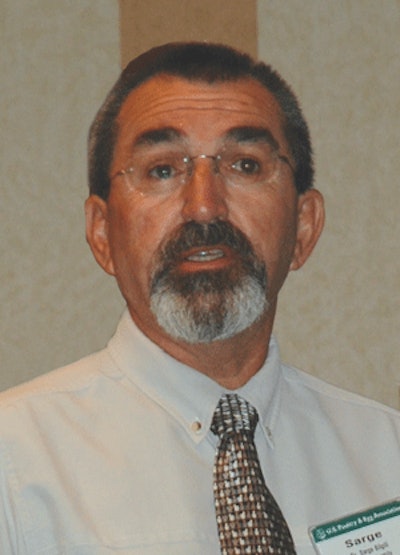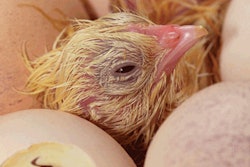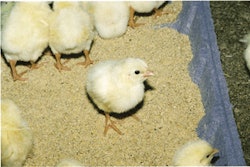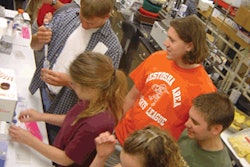
Growers and live production personnel know that the day chicks or poults arrive on the farm is probably the most critical day in the life of their flocks, and it is the day where proper handling and care can contribute the most to the flocks' bottom line performance. So, a tremendous amount of emphasis is placed on insuring that conditions are as good as they can be in the poultry houses and that every detail is taken care of even before the birds arrive.
Live haul and processing plant personnel only have contact with flocks on one day, the day the birds leave the farm and arrive at the plant. An argument can be made that this short window of time is really the most important day for a flock, because a full grow-out cycle of costs is in the birds at this point. A big broiler could have eaten 16 pounds of feed to get to market weight and a heavy tom could have eaten 100 pounds of feed. With corn at $7 per bushel, an individual 40-pound tom can have eaten $44 worth of feed, and an 8-pound broiler could have eaten $6.50 worth of feed. While catching, loading, transporting, unloading and live-hanging birds, is each tom being treated like the somewhat fragile $50-plus asset that it is?
Dr. Sarge Bilgili, poultry science professor, Auburn University, and Dr. James Barton, laboratory director, The Poultry Federation, each addressed the topic of bird welfare on this important last day of the life of a flock at the U.S. Poultry & Egg Association's Poultry Processor Workshop. Bilgili addressed welfare considerations of catching and transport of birds for processing, and Barton addressed welfare concerns inside the processing plant.
Live haul concerns
Bilgili said that catching, hauling, unloading and hanging are all stressful activities for broilers and turkeys. Care should be taken to minimize stress to the birds at each step in the process. Birds that die in the process of being loaded on the farm or transported to the plant are the most costly sign of stressed birds. Bilgili said it is important to perform post mortem examinations on dead-on-arrival (DOA) birds so that a cause of death can be determined and steps can be taken to minimize future losses.
The bigger the bird, the greater the chance of heat stress, according to Bilgili. Heat can build up quickly within loaded bird cages, particularly the middle cages. Establishing air movement through the cages as soon as possible after the cages are loaded can help minimize heat losses. Many broiler processors in the southeast have begun using fan trailers, either with or without evaporative cooling, which are parked alongside the live haul trailer as it is being loaded, to move air over the birds as soon as possible.
Bilgili said it is important to take into consideration the relative humidity of the air, not just the temperature when loading birds. When the relative humidity is near 100 percent, birds can be heat stressed at temperatures as low as the high 60s F. He said the problem is the microclimate around the bird in the middle of the cage. It does not matter if the temperature is comfortable outside the trailer if there is a pocket of hot, moist air surrounding the birds inside the cages. This is why air movement through the cage is important.
A broiler chicken is a juvenile animal. Bilgili said that the industry is processing bigger birds, but they are still not mature. Bilgili said today's market age broiler is like a 250-pound 11-year-old-child. Because of this relative immaturity, broiler carcasses are easy to damage. He said it is important to avoid piling up birds during catching or when dumping cages of birds.
Minimizing shrink prior to processing can have a real impact on the bottom line, according to Bilgili. After their digestive tract empties, birds shrink at a rate of 0.25 percent per hour at 70 F and at 0.40 percent per hour at 90 F. Shrink is a combination of moisture and tissue loss. Bilgili said that this is a real yield loss. Minimizing holding time on trailers can improve yield and reduce DOAs, particularly in warm weather. Some processors could improve their slaughter yield by reducing the cushion of trailers that they keep on their lots.
Welfare in the plant
Before going to work for The Poultry Federation, Barton worked for Tyson Foods Inc., where he had poultry welfare responsibility. He also worked for Indian River International, Zacky Farms and Cargill Turkey Products before working for Tyson. Barton said there is no substitute for spending time looking in the plant at the stunner and at the live-hang area.
He said that one has to go see it and make sure that everything is operating properly. One should have regular checks for personnel to perform in these areas. One needs to check to see that birds are properly hung in the shackles and that they are properly stunned. He said a pre-scalder check should be conducted on the birds as well. Barton said that the scalder is far enough past the stunner that needs to be checked to see that birds are still insensible to pain. Even though the birds should be dead at this point, there can be some involuntary muscle movement. One needs to be certain that twitching birds are insensible to pain.
Barton said that in his opinion, electrical stunning and CAS are equivalent as far as humaneness. The true benefit of CAS comes if the birds are stunned before removal from the cage. This means that the birds are not stressed and cannot injure themselves while being unloaded from the cage and hung on the line.
Based on his experience at Tyson, Barton said that a good hand-catching crew can do a better job minimizing broken wings than an automated catching machine can. He said automated harvesters are getting better and labor availability may force machine catching in the future, but hand catching, when properly supervised, does a better job. He said not all experts agree and that some claim that machine catching is better for the birds.
Barton made the point that some complexes do better than others on limiting the number of broken wings. With wings selling for $1 per pound, there is strong financial incentive to do the best you can on not breaking them. Barton said, "If you are not one of the best in the industry on broken wings, then you can improve and you should work on it."
"Everyone in your organization that comes into contact with live birds should be trained on proper handling once a year, and this training should be documented," Barton said. He explained that this training is important not just for what employees do at work. "Everyone is a spokesperson for the company, whether they want to be or not, whether they are prepared to be or not," Barton said.

















